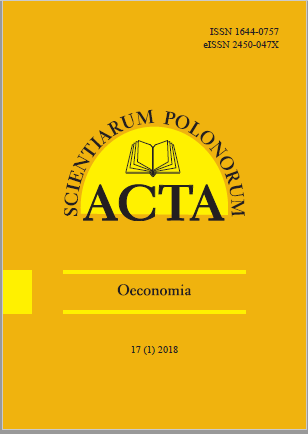ANALYSIS OF CONTRACT FARMING EFFECTS ON EFFICIENCY AND PRODUCTIVITY OF SMALL-SCALE SUNFLOWER FARMERS IN TANZANIA – A PROPENSITY SCORE METHOD APPROACH
ANALYSIS OF CONTRACT FARMING EFFECTS ON EFFICIENCY AND PRODUCTIVITY OF SMALL-SCALE SUNFLOWER FARMERS IN TANZANIA – A PROPENSITY SCORE METHOD APPROACH
Author(s): Daniel Mpeta, Joseph A. Kuzilwa, Batimo SebyigaSubject(s): Business Economy / Management, Agriculture, Methodology and research technology, Evaluation research, Financial Markets
Published by: Szkoła Główna Gospodarstwa Wiejskiego w Warszawie
Keywords: technical efficiency; propensity score method; contract farming; sunflower production; Tanzania;
Summary/Abstract: This paper attempts to measure and compare technical efficiency (TE) levels across small scale contract and non-contract sunflowers farmers in Kongwa district, in the central agricultural zone of Tanzania. Sunflower is not the ideal contract crop; it lacks conventional characteristics of a contract crop such as high perishability, product homogeneity, high hygiene, and safety requirement at the end market and product being hard to grow. We apply propensity score method of Rosenbaum and Rubin to mitigate bias arising from observed characteristics among farmers in both groups. Participating in contract farming lead to an average increase in technical efficiency of a farmer by 4.5–7.4%, and this impact is significant at 5% level. Similarly contract participation increases land productivity of a famer by an average, in the range of 20.8–25.1 kg·ac–1. This impact is significant at 5% and the expected output(total factor productivity) per acre of an average contract farm produces 24% more sunflower per acre than non-contract farm. Participation in contract farming has a significantly positive effect on the use of high-quality seeds, which can explain a part of the higher (land) productivity of contract farmers compared to non-contract farmers. By improving service provision from contract firms to farmers (e.g. improved seed provision), there is still a room to improve efficiency, thereby increasing productivity and total output.
Journal: Acta Scientiarum Polonorum. Oeconomia
- Issue Year: 17/2018
- Issue No: 1
- Page Range: 75-84
- Page Count: 10
- Language: English

